|
|
|
Sort Order |
|
|
|
Items / Page
|
|
|
|
|
|
|
| Srl | Item |
| 1 |
ID:
157488
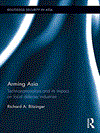

|
|
|
|
|
| Publication |
Oxon, Routledge, 2017.
|
| Description |
viii, 146p.hbk
|
| Series |
Routledge Security in Asia no;11
|
| Standard Number |
9781138892552
|
|
|
|
|
|
|
|
|
|
|
|
Copies: C:1/I:1,R:0,Q:0
Circulation
| Accession# | Call# | Current Location | Status | Policy | Location | IssuedTo | DueOn |
| 059308 | 338.4/BIT 059308 | Main | Issued | General | | RA70 | 19-May-2024 |
|
|
|
|
| 2 |
ID:
153714
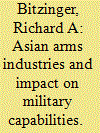

|
|
|
|
|
| Summary/Abstract |
Asia is a leading consumer of arms, and some of the most modern and most advanced armaments are finding their way into the inventories of Asian militaries. As a result, many Asian-Pacific militaries have experienced a significant, if not unprecedented, build-up over past several years, both in terms of quantity and quality. In addition to this trend, however, Asia has become an increasingly significant producer of armaments. Many nations in the region, if they can, have sought to supplant, or at least supplement, foreign arms suppliers with indigenous producers of needed weapons systems. However, for most Asian-Pacific militaries (the possible exception being China) indigenously produced weapons add only partial value to military capabilities. Consequently, imports of advanced weaponry remain a critical dependency for most of Asian-Pacific nations.
|
|
|
|
|
|
|
|
|
|
|
|
|
|
|
|
| 3 |
ID:
105083
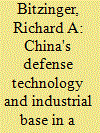

|
|
|
|
|
| Publication |
2011.
|
| Summary/Abstract |
This paper examines defense industrialization in three leading arms-producing states in Asia - India, Japan, and South Korea - and how their experiences compare to China's recent defense industrial developments. It argues that despite decades of considerable effort and investments in pursuit of a techno-nationalist self-arming strategy, these countries have experienced only modest success when it comes to achieving such self-reliance. Most regional defense industrial bases lack the necessary design skills and technological expertise in order to truly innovate, and at best these countries act as 'late innovators' when it comes to armaments production.
The experiences of these countries have lessons for China as it attempts to move into the first tier of arms-producing states. China has over the past 15 years made significant progress in modernizing its defense technological and industrial base. At the same time, China faces the same long-term challenges that currently confront other regional arms industries - that is, making techno-nationalism work at the later stages of innovation. This is particularly critical as China's defense industry strives to move from a basically platform-centric to an increasingly network-centric technological-industrial process.
|
|
|
|
|
|
|
|
|
|
|
|
|
|
|
|
| 4 |
ID:
066362


|
|
|
| 5 |
ID:
074433
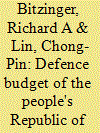

|
|
|
|
|
| Publication |
Washington, Defence Budget Project, 1994.
|
| Description |
37p.
|
|
|
|
|
|
|
|
|
|
|
|
Copies: C:1/I:0,R:0,Q:0
Circulation
| Accession# | Call# | Current Location | Status | Policy | Location |
| 037240 | 355.6220951/BIT 037240 | Main | On Shelf | General | |
|
|
|
|
| 6 |
ID:
142976
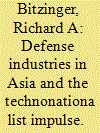

|
|
|
|
|
| Summary/Abstract |
Asia is a region of growing militarization and insecurity. It is increasingly characterized by rising defense expenditures and rapidly modernizing militaries, and subsequently it is increasingly becoming a zone of potential conflict. These security concerns are exacerbated by Asian countries’ expanding capacities for indigenous armaments production. Asian arms production is heavily influenced by concepts of techno-nationalism, which views autarky (self-sufficiency in armaments) as serving not only national defense needs, but also as maximizing national political, strategic, and economic autonomy. The technonationalist model is more than a set of goals; it also embodies a strategy for achieving autarky in armaments production, including the short-term exploitation of foreign-sourced technologies. What is the most interesting about Asian arms industries is how enduring they have been despite the fact that they produce few economic benefits and contribute so little to guaranteeing security of supply or expanding military-technological capacities for national defense. Asian armaments production has rarely been cost-effective or militarily significant in terms of turning out state-of-the-art military equipment. And yet, most large powers in Asia have not abandoned the idea of autarky in armaments production, often with explicit technonationalist industrial strategies. Despite problems with this technological-industrial approach, it is unlikely that these countries will abandon techno-nationalism anytime soon.
|
|
|
|
|
|
|
|
|
|
|
|
|
|
|
|
| 7 |
ID:
182632


|
|
|
|
|
| Summary/Abstract |
Both Israel and Singapore engage in military-technological innovation in areas deemed critical to strategic sovereignty. Both countries have consistently championed high levels of funding for military R&D and for maintaining and nurturing indigenous defense industries. Both countries have, to a varying degree, also strongly supported the cultivation of local S&T, including the spin-on of commercial high-technology breakthroughs into the defense sector. Israel has been more successful when it comes to military-technological innovation, mostly because it has to: its strategic situation is much more tenuous than Singapore’s. Singapore, on the other hand, faces much less of an existential threat, and so its military-technological innovation activities are more one of desire than necessity.
|
|
|
|
|
|
|
|
|
|
|
|
|
|
|
|
| 8 |
ID:
120253
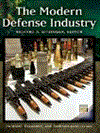

|
|
|
|
|
| Publication |
California, Praeger Security International, 2009.
|
| Description |
xi,375p.hbk
|
| Standard Number |
9780275994754
|
|
|
|
|
|
|
|
|
|
|
|
Copies: C:1/I:1,R:0,Q:0
Circulation
| Accession# | Call# | Current Location | Status | Policy | Location | IssuedTo | DueOn |
| 057278 | 338.47355/BIT 057278 | Main | Issued | General | | RF091 | 17-Jan-2024 |
|
|
|
|
| 9 |
ID:
094166


|
|
|
| 10 |
ID:
089152
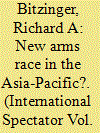

|
|
|
|
|
| Publication |
2009.
|
| Summary/Abstract |
Many countries in the Asia-Pacific, enabled by rising defence budgets and aggressive marketing by major arms-producing states, have since the middle of the 1990s greatly expanded their war fighting capacities beyond the mere modernisation of their armed forces. While such purchases are intended to aid deterrence and defence, they may have the unintended consequences of undermining regional security and stability by contributing to arms races or arms competitions leading to a classical 'security dilemma'.
|
|
|
|
|
|
|
|
|
|
|
|
|
|
|
|
| 11 |
ID:
156601


|
|
|
|
|
| Summary/Abstract |
The People's Liberation Army (PLA) has been undergoing a profound transformation in terms of its operational capabilities, both with regard to its hardware as well as its heartware, i.e. the softer aspects of its development including its operational culture and military ethos. These changes have permeated every facet of the PLA – technological, organizational and doctrinal. Despite successive generations of Chinese leaders having declared their adherence to “peace” and “development,” it has become clearer that Beijing's security policy under Xi Jinping has shifted steadily away from “keeping a low profile.” In that regard, the status of the PLA in the domestic and international calculus of China's new commander-in-chief has, unsurprisingly, become more pronounced, with Xi taking noticeably greater interest in harnessing the Chinese Communist Party's coercive forces as his personal domestic powerbase and foreign policy instrument complementing China's hard economic power.
|
|
|
|
|
|
|
|
|
|
|
|
|
|
|
|
| 12 |
ID:
181581


|
|
|
|
|
| Summary/Abstract |
Where China’s military build-up is concerned, adding some context to make up for the lack of transparency in its annual budget provides us with a better—albeit still limited—appreciation of the People’s Liberation Army budgetary allocations.
|
|
|
|
|
|
|
|
|
|
|
|
|
|
|
|
| 13 |
ID:
072448
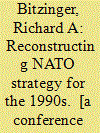

|
|
|
|
|
| Publication |
Santa Monica, Rand Corporation, 1989.
|
| Description |
xi, 42p.
|
| Standard Number |
0833009869
|
|
|
|
|
|
|
|
|
|
|
|
Copies: C:1/I:0,R:0,Q:0
Circulation
| Accession# | Call# | Current Location | Status | Policy | Location |
| 031007 | 355.031091821/BIT 031007 | Main | On Shelf | General | |
|
|
|
|
| 14 |
ID:
148219
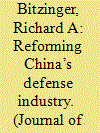

|
|
|
|
|
| Summary/Abstract |
Even with sizable economic inputs, access to foreign technologies, and considerable political will, China, up until the late 1990s, experienced only limited success when it came to the local design, development, and manufacture of advanced conventional weapons. Not surprisingly, therefore, reforming the local defense industry in order to upgrade its technology base and manufacturing capabilities and to make armaments production more efficient and cost-effective has long preoccupied the Chinese leadership. The fact that most of these efforts had little positive impact on the country’s military technological and industrial capabilities only encouraged Beijing to experiment with additional reforms in the hopes of finally getting it right.
|
|
|
|
|
|
|
|
|
|
|
|
|
|
|
|
| 15 |
ID:
078730
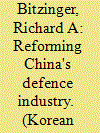

|
|
|
| 16 |
ID:
124473


|
|
|
|
|
| Publication |
2013.
|
| Summary/Abstract |
Several states in Southeast Asia have long attempted to produce their own armaments, both to support national security and to aid in national economic and technological advancement. In most cases, however, such efforts have been decidedly disappointing, and few local arms industries have been economically or technologically self-sustaining. Nevertheless, we may be witnessing a new phase of renewed interest among several Southeast Asian nations in expanding their capabilities for indigenous arms manufacturing, as evidenced in particular by new defence-industrial initiatives in Indonesia and Malaysia. These efforts have been supported by a long-term growth in defence expenditures and new efforts to utilize industrial offsets (such as technology transfers and localized production) as a part of arms acquisitions to build up local arms industries. It is unlikely, however, that these efforts alone will suffice to create economically viable local defence industries. Consequently, countries in the region will still have to make tough decisions about the future course of their defence industrial bases. Most likely, they will have to either invest considerably greater resources into developing their defence sectors (which may beyond their capacities and which are still no guarantee of success) or else they have to scale back their ambitions and choose to concentrate in niche areas where they have a better chance of being competitive in the global arms marketplace.
|
|
|
|
|
|
|
|
|
|
|
|
|
|
|
|
| 17 |
ID:
071204
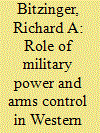

|
|
|
|
|
| Publication |
Santa Monica, Rand Corporation, 1990.
|
| Description |
ix, 27p.
|
| Standard Number |
0833011065
|
|
|
|
|
|
|
|
|
|
|
|
Copies: C:1/I:0,R:0,Q:0
Circulation
| Accession# | Call# | Current Location | Status | Policy | Location |
| 032901 | 355.03304/BIT 032901 | Main | On Shelf | General | |
|
|
|
|
| 18 |
ID:
187343
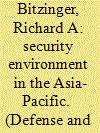

|
|
|
|
|
| Summary/Abstract |
Countries in the Asia-Pacific have many reasons for acquiring new defense hardware and improving national military capabilities. The region is clearly one of constantly shifting security dynamics, with rising great powers, new threats and security challenges, and new military commitments. All of these require new capabilities for power projection, mobility, firepower, intelligence and surveillance, and joint operations, thereby driving regional military modernisation. Consequently, some of the most modern and most advanced armaments are finding their way into the inventories of Asian militaries. Many regional militaries have experienced a significant, if not unprecedented, build-up in terms of both quantity and quality, over the past several years. Recent acquisitions by regional armed forces constitute something more than mere modernisation; rather, the new types of armaments being procured and deployed promise to significantly expand regional maritime and airborne warfighting capabilities.
|
|
|
|
|
|
|
|
|
|
|
|
|
|
|
|
| 19 |
ID:
072460


|
|
|
|
|
| Publication |
Santa Monica, Rand Corporation, 1990.
|
| Description |
xi, 25p.
|
| Standard Number |
0833010344
|
|
|
|
|
|
|
|
|
|
|
|
Copies: C:1/I:0,R:0,Q:0
Circulation
| Accession# | Call# | Current Location | Status | Policy | Location |
| 031954 | 355.0217094/BIT 031954 | Main | On Shelf | General | |
|
|
|
|
| 20 |
ID:
065038
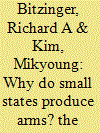

|
|
|
|
|
|
|
|